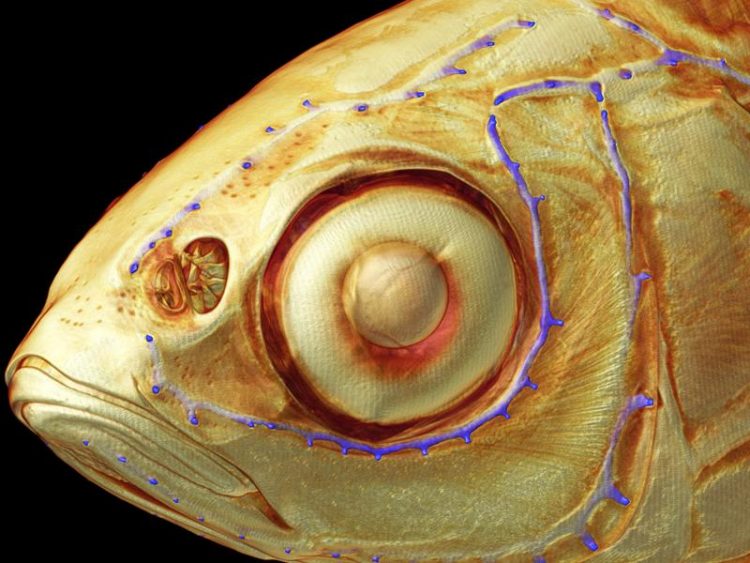How do fishes perceive their environment?

In this image generated using micro-computed tomography, the blue dyed lateral lines of the ide (Leuciscus idus) are clear to see. Source: Dr. Hendrik Herzog
The ide (Leuciscus idus) is a fish that inhabits the lower stretches of slow-flowing rivers. Like most fishes, it can perceive the current using its lateral line. The mechanoreceptors of this organ are distributed over the surface of the entire body, which is why the organ provides a three-dimensional image of the hydrodynamic conditions.
Fishes can thus also find their way around themselves in the dark and identify prey, conspecifics, or predators. The recently retired zoologist Prof. Horst Bleckmann from the University of Bonn has spent many years researching the sensitive organ and has used it as inspiration for technical flow sensors in order to, for instance, identify leakages in water pipes.
First realistic three-dimensional computer model
The scientists Dr. Hendrik Herzog from the Institute of Zoology and Dr. Alexander Ziegler from the Institute of Evolutionary Biology and Ecology at the University of Bonn have now entered a new dimension of research into the lateral line in fish: they created the first realistic, three-dimensional computer model of the lateral line system, which they used to calculate the precise flow conditions of the surrounding water.
“We concentrated on the head of the ide, because the lateral line of the fish has a particularly complex form there,” reports Dr. Herzog.
This organ has two different types of sensors. Some protrude like small bumps from the surface of the fish’s skin and the water flows directly over them. Others sit in canals that are submerged into the cranial bone and are connected to the water via small pores. “If prey, such as a freshwater shrimp, is close by, the local water current and pressure conditions change,” explains Dr. Ziegler. The fish registers this with its many sensors. “However, until now, the actual function of such different types of current measurement had not been clarified conclusively.”
Both researchers received active support from Birgit Klein from the Westphalian University of Applied Sciences. In her bachelor thesis at the Institute of Zoology, the current master student compared various methods of 3D reconstruction. She took around 350 photos of the head of the ide from various angles and used them to produce a 3D model of the fish surface. She had dyed the channels and sensors of the lateral line beforehand, which is why the structures in the model can be clearly identified. She then optimized the dataset by digitizing the fish head using a much higher-resolution laser scanning procedure.
This created a realistic image of the fish surface, but the inside of the animal was not recorded in this way. This is why the researchers used a micro-computed tomography scanner as the third method. A contrast agent allowed the soft tissue to be shown even when using this X-ray technique. At the end, data from all three techniques flowed into the realistic model of the lateral line. The zoologists thus simulated various current conditions and calculated the hydrodynamic signals to the various sensors.
A strong current is a challenge for the fish, as the background noise for the sensors is particularly great. Nevertheless, the fish can precisely perceive its environment even with high water speeds. As the researchers show with their calculations, depressions ensure that the current is significantly reduced for the bump-like sensors that sit on the surface of the skin. “The relative signal strength of, for instance, prey organisms thus becomes greater,” explains Dr. Herzog. For the sensors in the channels, it was shown that certain sections of the lateral line are particularly sensitive to the respective current strength due to different channel diameters.
Bio-inspired application: improved navigation of underwater robots
“Using our methodical approach, comparative anatomical studies between different fish species with an especially high level of detail will be possible in the future,” reports Dr. Ziegler. His colleague sees bio-inspired applications in the foreground: “The knowledge from such 3D models of fish may also make it possible to significantly improve the autonomous navigation of underwater robots using flow sensors,” suggests Dr. Herzog.
Publication: Form and function of the teleost lateral line revealed using three-dimensional imaging and computational fluid dynamics, The Journal of the Royal Society Interface
Media contact:
Dr. Hendrik Herzog
Institute of Zoology
University of Bonn
Tel. +49 (0)228/735490
E-mail: hendrik.herzog@uni-bonn.de
Dr. Alexander Ziegler
Institute of Evolutionary Biology and Ecology
University of Bonn
Tel. +49 (0)228/735758
E-mail: aziegler@evolution.uni-bonn.de
http://dx.doi.org/10.1098/rsif.2016.0898 Publication
Media Contact
More Information:
http://www.uni-bonn.de/All latest news from the category: Life Sciences and Chemistry
Articles and reports from the Life Sciences and chemistry area deal with applied and basic research into modern biology, chemistry and human medicine.
Valuable information can be found on a range of life sciences fields including bacteriology, biochemistry, bionics, bioinformatics, biophysics, biotechnology, genetics, geobotany, human biology, marine biology, microbiology, molecular biology, cellular biology, zoology, bioinorganic chemistry, microchemistry and environmental chemistry.
Newest articles

Superradiant atoms could push the boundaries of how precisely time can be measured
Superradiant atoms can help us measure time more precisely than ever. In a new study, researchers from the University of Copenhagen present a new method for measuring the time interval,…

Ion thermoelectric conversion devices for near room temperature
The electrode sheet of the thermoelectric device consists of ionic hydrogel, which is sandwiched between the electrodes to form, and the Prussian blue on the electrode undergoes a redox reaction…

Zap Energy achieves 37-million-degree temperatures in a compact device
New publication reports record electron temperatures for a small-scale, sheared-flow-stabilized Z-pinch fusion device. In the nine decades since humans first produced fusion reactions, only a few fusion technologies have demonstrated…





















